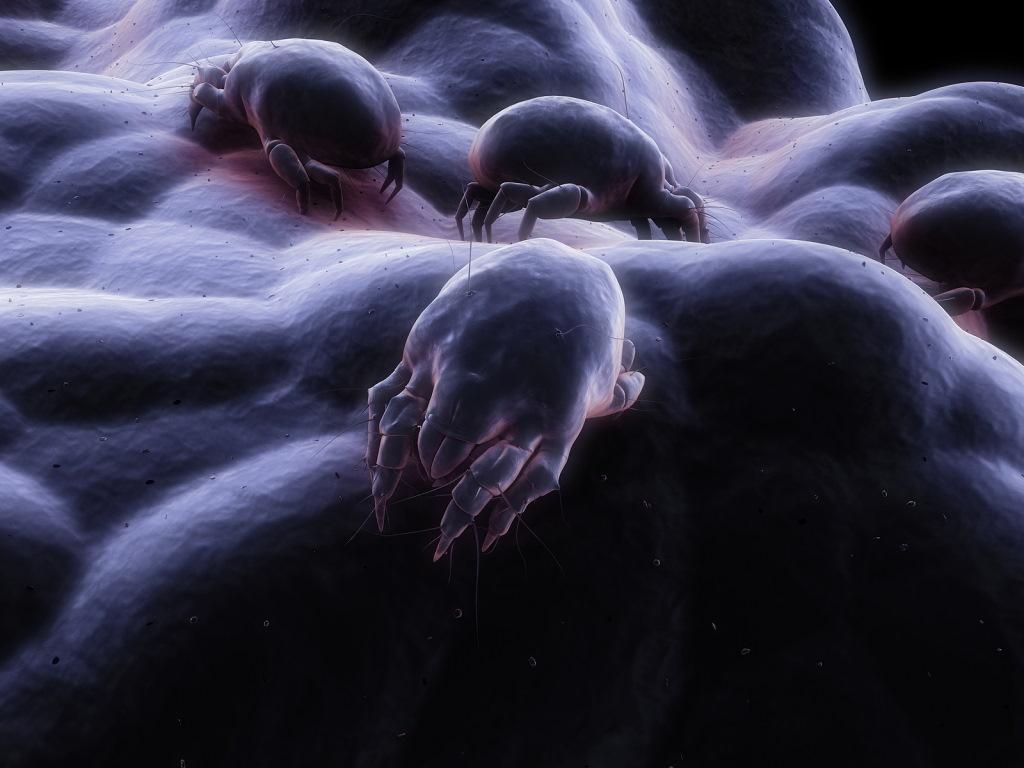
Dust mites are tiny little critters that invade the most intimate spaces in our home. They’re pervasive, difficult to detect and require a multifaceted prevention and cleaning strategy to keep them in check.
It’s not a question of “are there dust mites in my home?”. It’s more, “what can I do about these unwelcome house guests” and “why should I bother”?
Here’s what you need to know about dust mites and the effect they can have on your family’s health.
How do I tell if I have dust mites?
Dust mites are invisible to the naked eye. They don’t leave obvious signs, but they’re in your bedding, upholstery, carpets, soft furnishings and toys.
Unless you have X-ray vision, there’s only one sure sign of dust-mite infestation – year-round sneezing, wheezing, spluttering, itching and watery, rheumy eyes. These are the symptoms commonly associated with exposure to dust-mite allergens.
Dust-mite allergy is particularly common in children, especially toddlers, as well as asthma and hay fever sufferers, and people with compromised immune systems. More than 400 million people worldwide suffer from dust-mite allergies.
If no-one in the household is susceptible to allergens, you may never know you have dust mites.
Are dust mites common in Cape Town?
According to an article by South African paediatrician Dr Thulja Trikamjee, “House dust mites are one of the most common allergen sources in South Africa, particularly in coastal areas.”
The mites thrive in warm, humid conditions typical of cities like Cape Town. Year-round temperatures of between 18 and 24°C, coupled with 75 to 80% humidity, is dust-mite heaven.
Conditions are so perfect that as many as 10 different species of dust mite have been identified in Cape Town, Gqeberha and Durban.
Basic facts about dust mites
There are more than 40 species of house mites and they have these factors in common:
- the average bed hosts around 500,000
- they feed on dead skin cells
- average lifespan of 10 weeks
- the female dust mite lays up to 100 eggs.
Dust mites vs. bed bugs
Dust mites and bed bugs both inhabit our beds but that’s where the similarity ends. Dust mites are tiny, white tick-like creatures of up to 0.3 mm in length. Bed bugs are around 5 mm in length, reddish brown and have flat, rounded bodies.
Dust mites eat our old dead skin scales we shed as we sleep. Bed bugs are parasites that feed off human blood.
Bed bugs leave nasty bites that can become red, infected and inflamed. Dust mites can’t bite but their faeces are highly allergic.
Dust mites are eight-legged creatures related to spiders and ticks. They’re not visible without magnification, but bed bugs can be seen with the naked eye.
Why get rid of dust mites?
Dust mites are a major trigger of year-round allergic symptoms. Apart from the discomfort of respiratory problems, post-nasal drip and other allergic reactions, dust-mite allergens are believed to be instrumental in the development and severity of eczema and asthma.
Similarly, 80% of children with asthma, and a significant percentage of kids with eczema, are highly sensitive to dust-mite allergies. Reducing the source of the problem is the first step to a healthier family.
How to get rid of dust mites in Cape Town
Eradicating dust mites completely from your home is virtually impossible. That said, there are easy ways of controlling infestations and removing the faecal matter responsible for allergies.
Wash bedding in hot water
Dust mites can’t survive in temperatures above 60°C. Washing sheets, pillow cases and duvet covers once a week on the hot-water setting is a must.
Use a dehumidifier
Dust mites absorb water from ambient air. When the humidly falls below 50%, the mites don’t get sufficient hydration and die. Installing a dehumidifier in each bedroom may be pricey but it’s a long-term solution scientifically proven to work.
Deep freeze soft toys and accessories
Temperatures below freezing annihilate dust mites. Toys, fabrics and accessories that are not hot-water washable can be treated by popping them into plastic bags and into the freezer for 48 hours.
Steam clean mattresses
Dust mites die at high temperatures. Steam cleaning delivers blasts of high temperature vapour into the mattress. The steam extraction technique lifts and removes faeces and mite detritus from the ticking and comfort layers.
Invest in hypoallergic bedding and mattress covers
Hypoallergic bedding is finely woven sheets, pillow cases and duvet covers that are specially designed to reduce allergic reactions. It prevents dust mites from creeping into the bedding.
Non-allergy mattress protectors are also effective barriers that prevent dust mites, bed bugs and other allergens from accumulating and creating colonies in the mattress.
Remove bedroom carpeting
Dust mites love the snug, warm environment of a fitted carpet. The easiest way to control the spread is to lift the carpeting and make do with a solid wood or tile floor instead.
Advantages of mattress deep-cleaning
Deep-cleaning all the mattresses at least once a year is beneficial for a number of reasons:
- It improves the quality of air in the bedrooms.
- Dead skin flakes, the key food item on the dust mite menu, are removed from deep inside the mattress, along with dust, pollen and pet dander.
- Mites, bed bugs and other creepy crawlies are killed by the steam.
- Stains and other human residue are removed, leaving the mattress clean, fresh and sanitised.
Chelsea Cleaning
At Chelsea Cleaning, we offer professional help in getting rid of dust mites in Cape Town. Our trained team of specialist cleaners use latest-generation cleaning equipment and materials to deliver the best results, removing dust mites from carpets, rugs, mattresses and soft furnishings. Contact us at Chelsea Cleaning. We’ll be happy to assist.
Contact us now


